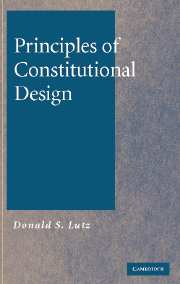Book contents
- Frontmatter
- Contents
- Preface
- Acknowledgments
- Principles of Constitutional Design
- 1 Constitutionalism: An Initial Overview and Introduction
- 2 Sovereignty
- 3 Popular Sovereignty
- 4 The Separation of Powers
- 5 Analyzing the Interaction between Popular Control and the Separation of Powers in the Amendment Process
- 6 Matching a Government to a People
- 7 An Overview of the Constitutional Design Project
- 8 An Underlying Constitutional Logic: Rational Actors?
- Index
7 - An Overview of the Constitutional Design Project
Published online by Cambridge University Press: 29 July 2009
- Frontmatter
- Contents
- Preface
- Acknowledgments
- Principles of Constitutional Design
- 1 Constitutionalism: An Initial Overview and Introduction
- 2 Sovereignty
- 3 Popular Sovereignty
- 4 The Separation of Powers
- 5 Analyzing the Interaction between Popular Control and the Separation of Powers in the Amendment Process
- 6 Matching a Government to a People
- 7 An Overview of the Constitutional Design Project
- 8 An Underlying Constitutional Logic: Rational Actors?
- Index
Summary
It is time to step back and consider how the various pieces discussed thus far fit together. We must consider first how they form a coherent project and then how the various principles are related and the ways they contribute. As a coherent project, constitutional design takes its form from political philosophy in general, because the constitutional project is historically the result of, and an offshoot from, Western political philosophy. This is not to say that constitutionalism is the central concern of political philosophy or that all political philosophers have contributed to constitutional thinking. Instead, constitutionalism is so deeply embedded in Western political philosophy that the content of constitutionalism and the method for pursuing it cannot be separated from Western philosophy. In large part, this resulted from the project being defined by early political philosophers as they engaged in defining the broader philosophical tradition. In Chapter 6 we considered some of Plato's contributions to defining and advancing constitutionalism, but it is to Aristotle we must turn for laying out the coherent project in which we are now engaged.
Political Philosophy as an Integrated Project
Aristotle notes in the Politics that political theory proceeds simultaneously at three levels: discourse about the ideal, about the best possible in the real world, and about existing political systems (1288b21). Put another way, comprehensive political theory must ask several different kinds of questions that are linked, yet distinguishable.
- Type
- Chapter
- Information
- Principles of Constitutional Design , pp. 209 - 220Publisher: Cambridge University PressPrint publication year: 2006



